Tearing during birth is a common fear of expectant mothers, with good reason, as a local OB once told me that the average first time mother experiences a second degree tear. It would seem that the use of perineal massage during pushing, the preferred method to prevent tearing during birth at the hospital, is not working. So then, what does work?
In this blog post we discuss what works and what doesn’t in regards to tearing during birth. I hope that the information you learn changes the way you give birth, but beyond that, changes the culture in which you give birth. I believe that change is possible, especially when it begins with you.
How to Prevent Tearing During Birth, Revisited
Mother Rising has a very popular article about tearing during birth that published in 2016. Since then I’ve learned some new information on the topic I’d like to present and old ideas I’d like to reconsider. Let’s get to it!
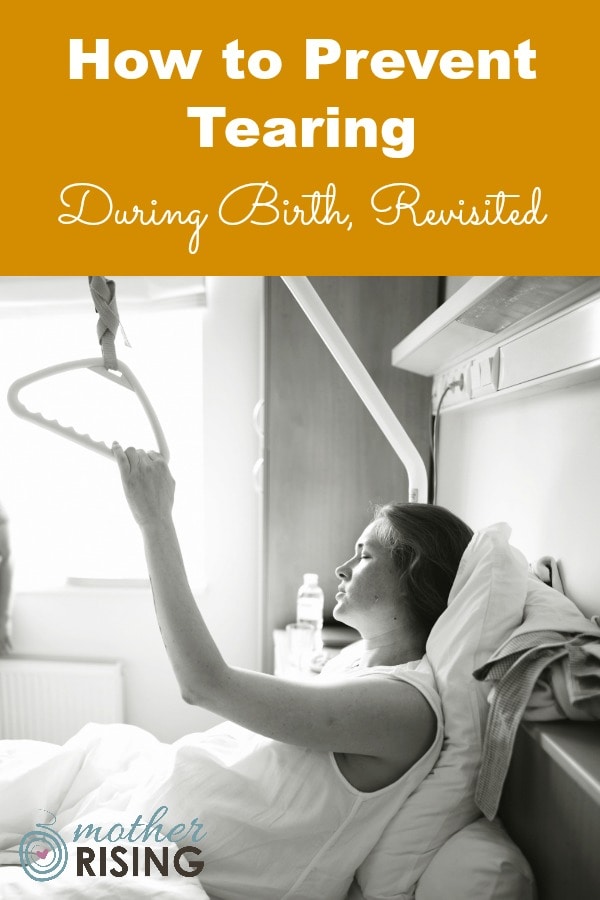
Things a Woman Can Do
When it comes to preventing tearing during birth, there are two parties that need to be addressed – a woman and her care provider. First, let’s consider what a woman can do to prevent tearing during birth – positioning, relaxation, health, and nutrition.
1. Positioning
The semi-reclined lithotomy position is what most women use when pushing at hospital births. Despite the convenience this position offers care providers, it’s one of the more common mistakes that don’t actually prevent tearing.
On the other hand, when left alone, women will typically assume a position for birth that is exactly what is needed. It’s instinct. Furthermore, as she progresses through the second stage of labor (the pushing stage), she will change positions as needed for comfort, baby’s needs, and labor progress.
In the photo below I am pushing in a kneeling/side lunge position that I instinctually assumed once I felt the urge to push. The water helped me easily move into that position and maintain it throughout the pushing stage (which was only minutes).
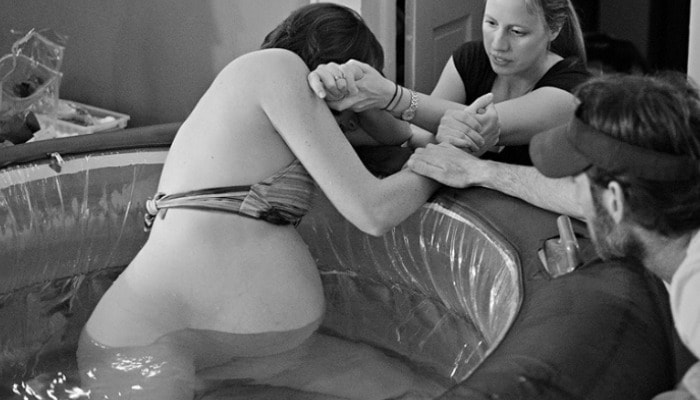
According to one study, birthing positions that take pressure off the sacrum like kneeling, standing, all‐fours, side-lying, and on a birth seat, may help prevent tearing during birth. (SOURCE)
Squatting
Squatting provides a 20-30% greater pelvic opening compared to lying flat on one’s back. It would make sense that pushing in the squatting position would make for an easier pushing experience. Squatting is a great position to push out baby, however, it’s also unfortunately associated with an increase in tearing during birth.
It’s true, squatting does increase tearing during birth, but that’s not necessarily the case in cultures where squatting is part of every day life. In my opinion, squatting increases tearing during birth because women that don’t squat in their daily life, squat incorrectly, and don’t have the physical endurance to hold the squat (during contractions) throughout the pushing stage.
To take advantage of squatting during birth but avoid tearing, it’s important to learn how to squat correctly by incorporating it in the daily activities of life. The women below are squatting while they shell prawns. It’s obvious by their form and flat feet, that squatting is a part of their daily life. The next time you’re preparing dinner, see what foods you can chop while squatting. Vegetables are a good choice!
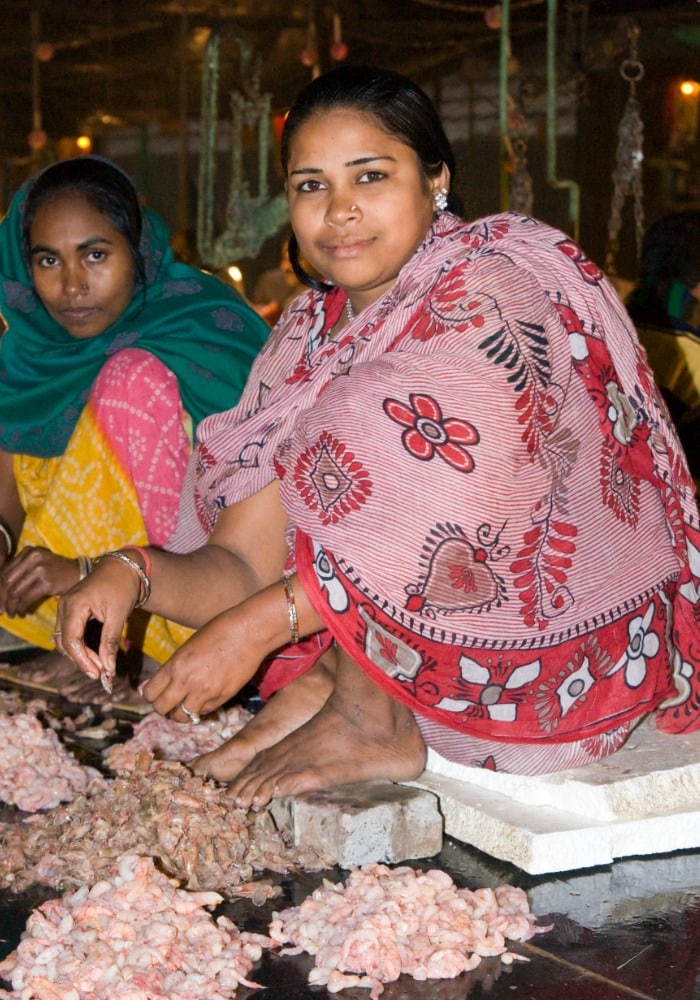
TIP: An easy way to help maintain a squat during pushing is to use water. Water gives the ability to change and maintain positions much more easily than if on land.
2. Relaxation
Tension plays a role with tearing during birth. Anything a woman can do to reduce tension and encourage relaxation, will help the body to do what it instinctively knows to do. An easy way to think about this is to encourage a birthing environment that is conducive to oxytocin and eliminates adrenaline. The same environment that helps make a baby helps get the baby out. 🙂
The following are specific ideas ways to experience a more relaxing birth.
Eliminate Fear
When the body is fearful, it instinctively tenses to protect itself, which makes so much sense. What doesn’t make sense, however, is a tensed body during birth. One way to eliminate fear at birth is to to address fears prenatally, as much as possible, so as to avoid the fight or flight response during birth. It is possible to give birth without fear!
Relax the Jaw
During birth it may be difficult achieve total relaxation if all a woman hears is to “just relax”. Being more specific by pinpointing a specific body part is much more doable. Try saying the following to yourself, or a laboring mother, and you’ll likely be more helpful.
“A relaxed jaw is an open vagina.”
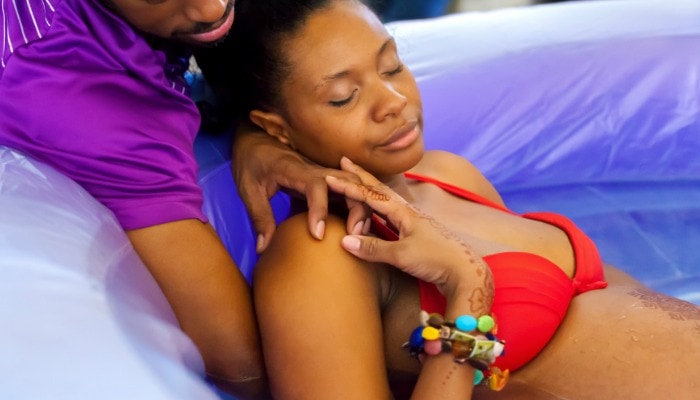
Try Kissing
A fun, and even more effective way to relax the jaw, is to kiss your partner. Not only will the jaw relax (hopefully!), but your body will release more feel-good, labor encouraging hormones like oxytocin and endorphins. According to Ina May Gaskin, she’s never seen a woman kissing her way through pushing that also tears during birth. If that’s not fabulous news, I’m not sure what is. 😉
Don’t Forcefully Push
If a woman is pushing in a way that is forceful and unnatural, odds are she is experiencing coached pushing instead of spontaneous, undirected pushing. For a woman that is unmedicated, it’s best to be hands off physically, but also with directed pushing.
Coached or forced pushing may sound like a nurse instructing a woman to hold her breath while counting to ten, two to three times during each pushing contraction. It may also look like a doctor or midwife telling a woman to push after baby’s head is out, but between contractions, when she has no urge to push. (You can read more about this phenomenon below.)
Push with Great Strength, Slowly and Gently
Instead, it’s best to push instinctively with great strength, but slowly and gently. Before baby is crowning, it may be helpful to envision pushing with the strength of a gorilla. However, when baby is crowning, pushing slowly and gently is a great way to prevent tearing.
Listen to your care provider as they guide you through these intense moments of birth. You may want to push like a wild woman and “get the baby out”, but anything you can do to allow things to unfold slowly will help keep your lady bits intact.
Choose Waterbirth
You know how you feel when you step into the shower after a long, difficult day? Or how about when relaxing in a nice, warm bath? Just because a woman is in labor does not negate the therapeutic effects of water. A wonderful way to relax in labor and during the second stage, is with waterbirth.
Not only does waterbirth encourage whole body relaxation, it also allows women to assume different positions with ease, further allowing them to relax their bodies throughout labor.
In my previous article about preventing tearing during birth I shared a research study that showed waterbirth was associated with an increase risk in tearing. However, I spoke with Barbara Harper (THE person to talk to about waterbirth) about this, and she disagrees that this phenomenon is a hard and fast truth. She shared with me that just because a woman has a waterbirth, does not mean that her birth is guaranteed to be gentle. Let me explain…

(Barbara Harper and I, during our interview at her home in July 2018.)
Gentle Waterbirth
As an international midwife, Barbara Harper travels globally educating care providers about waterbirth. Because of this, she has the opportunity to observe different labor and delivery practices in hospitals around the world. At one point in our conversation, she brought up India. Despite having access to water birth, most hospital births there are not gentle. Many women in India receive episiotomies, even those giving birth in water.
Their care providers often say that Indian women are just smaller, and therefore inadequate to stay intact while giving birth. Ironically, there is a large Indian population in the UK giving birth and not needing episiotomies. Why is that?? Well, it’s not because something magical happens to these women’s bodies when they cross the border and it certainly has nothing to do with the weather. 😉
According to Barbara Harper, waterbirth can remain gentle by simply following a woman’s instincts AND using a care provider that understands and practices gentle birth. When using the suggestions in this article to prevent tearing, and not just moving what happens in some hospital beds to a birthing tub, women will experience more gentle births and intact perineums.
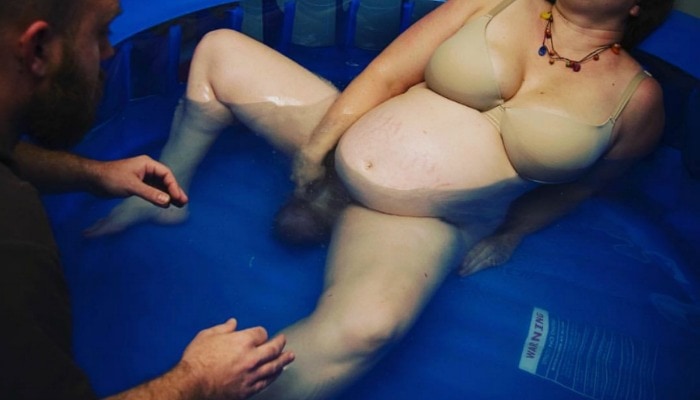
(Photo Credit: Indie Birth Association)
3. Health and Nutrition
Living a healthy lifestyle and eating nourishing foods during pregnancy is the foundation to a healthy pregnancy, natural birth, and happy postpartum. Because of this, I think it’s safe to assume that, for example, not smoking and eating healthy will help the body and skin to grow and stretch beyond its perceived limits with little or no damage.
For an amazing resource on eating well during pregnancy, check out Lily Nichols Real Food for Pregnancy. It’s hands down, my favorite book on nutrition during pregnancy.
“If women were taught the knowledge contained in Real Food for Pregnancy and given the resources to make it happen, our world would quite literally be a different place. Backed by well documented research, Nichols helps parents choose the best foods for a healthy pregnancy, natural birth, and happy postpartum. As a childbirth educator, doula, and pregnancy blogger, I’m thrilled to finally have a resource on pregnancy nutrition that I can endorse.” – Mother Rising
Things a Care Provider Can Do
Now that we’ve discussed things a woman can do, let’s talk about things a care provider can do to prevent tearing – being hands off, using warm compresses, and waiting.
1. Hands Off, Hands Poised
According to the research, the best thing a care provider can do to help prevent tearing is to keep their hands off, but hands poised instead.
Bye Bye Perineal Massage
This means perineal massage, a standard practice in many communities, needs to go.
Perineal massage is when a care provider pre-stretches the perineum, labia and vulva (all the things) during the pushing stage, right before crowning. This is a very “hands on” tactic. With lubricating jelly, a nurse, doctor or midwife places two fingers in the vagina, and pushes down and side to side, over and over again.
This practice actually swells the skin and tissues, making a woman more likely to tear. Perineal massage doesn’t work and needs to stop.
NOTE: Perineal massage, when done during pregnancy, has been shown to reduce the risk of an episiotomy with first time moms. However, in my experience, this risk is drastically reduced by choosing the right care provider. Have a talk with your care provider and ask them about their episiotomy rates. I bet the conversation will be very interesting!
A Note to Nurses
A common practice for OB’s is show up at the end of labor, when baby is crowning, instead of attending the whole birth. A consequence of this is that nurses are managing most of the labors, including the pushing stage. This also means that nurses provide perineal massage, solely because this is the expectation.
Nurses, you have the ability to change the birthing culture in your hospital, simply by following evidence based practices, instead of doing what everyone else is doing. Sure, maybe a more hands-on approach makes more sense with a woman that has an epidural – she likely needs more feedback from you to make progress.
However, encourage unmedicated mothers to follow their instincts with your fingers out of their vaginas. This will be a step into the unknown, which can be a little scary, but in that way you’ll partner with this laboring mother. She too, is walking in the unknown.

Waterbirth
Generally speaking, a waterbirth may encourage more of a “hands off” approach to birth as it’s literally more difficult to be hands on when a woman is giving birth in a tub. In one study I saw that women that gave birth in water had drastically less episiotomies when giving birth in water. This makes so much sense – it’s harder to perform an episiotomy on a woman when she is in a tub! (SOURCE) —>>> If you click through to read that study you’ll also notice that the women giving birth on the bed instead of a tub or stool, had higher tearing rates. Interesting.
2. Warm Compresses
A wonderful compromise to being completely hands off are to use warm compresses, which are gentle, so simple, and easily accessible. The warmth of the compress, coupled with firm support to the perineum, has been shown to decrease tearing.
To start, find a small basin and a stack of about 5 washcloths.
- Fill the basin with very warm water.
- Place the washcloth in the water, and wring it out.
- If the washcloth is too hot for your fingers, it’s too hot for mom. Wait until it cools some.
- With firm pressure, place your hands and washcloth on mom’s perineum while baby crowns.

TIP: Using ginger will further help reduce inflammation.
3. After the Head is Born, Wait
Finally, I’d like to introduce an idea on preventing tearing that is generally not discussed or considered. Minimizing tearing during birth can be facilitated by care providers when they give the opportunity for baby to be born during two contractions – one for the head and the second for the body – and not just one.
After the head is born, by allowing the baby to instinctively rotate on its own and waiting for the mother to experience another involuntary push, the body will be given the space it needs to birth in a gentle way. (BACKED BY RESEARCH, Y’ALL —->>>>> SOURCE)
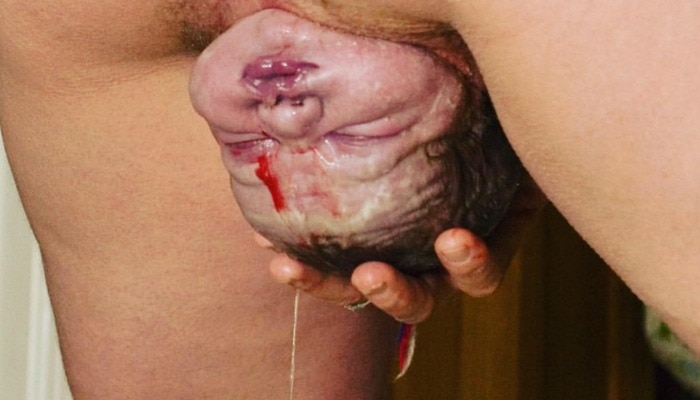
(Photo Credit: Indie Birth Association)
Having said that, I realize this is a tall ask of most care providers. You see, the standard procedure for most is to intervene if the baby’s isn’t completely born within 30 seconds after baby’s head.
I experienced this first hand at my son’s birth. I pushed my son’s head out during one contraction, that contraction went away (as they always do), and I stopped pushing while the rest of his body remained inside of me. My midwife, however, impressed it upon me that I should continue to push and get him out NOW. I remember her saying, “PUSH, Lindsey!”.
Based on how my midwife was acting, it seemed like an emergency. However, years later I looked at my records and there was no huge lapse in time after his head was born. My body was just waiting for the next contraction. I wasn’t given the option to wait for the next contraction because my midwife pulled my son out after that. That’s when I felt myself tear.
30, 30, 30
A few years later, I became a birth assistant and was given the opportunity to witness women and babies having the time and space to deliver baby’s head and body in more than one contraction. It was affirming to see this happen with no adverse affects.
However, I will say that if you’re accustomed to GETTING THE BABY OUT NOW, waiting for the next contraction after the head comes out, will feel like one of the longest waits of your life.
While baby’s between two worlds, it may be best to wait. During this challenging time, grab a cup of tea or sit on your hands. 😉 According to Barbara Harper, if after 30 seconds of waiting nothing happens, move mom into a new position. Every 30 seconds after that, try a new position until baby is born. 30, 30, 30.
Care Provider = Biggest Influencer
After reading this article, it’s easy to see that the choice in care provider is possibly the biggest influencer when it comes to reducing tearing during birth. It’s important to find a care provider that accepts and operates within the confines of true evidence based practices. It’s a treasure to find a person with the ability to question their birth culture or “how we do things around here”.
A good care provider is vulnerable enough to admit wrong thinking and courageous enough to operate differently moving forward.
At your next prenatal appointment, ask your care provider a few key questions to gauge their character and how they operate.
- I want to push my baby out in _____________ position. What are your thoughts about this?
- In your practice, what degree of tearing is most common with first time moms?
- How can I reduce tearing?
- I’ve heard that ____________ reduces tearing. Would you be willing to help me with this?
If you’re unsure if your care provider is the right choice for you, read this article about 15 signs that it’s time to fire your OB.
Leave a Comment
Leave a comment and let me know your thoughts about reducing tearing during birth. I’d love to hear from you!


Bianca Asiya
Wednesday 16th of January 2019
Wow, this is such an in-depth and detailed guide to preventing tearing. I really appreciate this and will share it with my community. What I loved most about your article is that you shared your personal experience over a span of years, included research, and conducted your own interviews. Very informative and valuable.
It's so important for us mothers to change the birthing culture and leave a place for future generations that is more sustainable and less traumatic.
Thanks, B
Lindsey
Wednesday 16th of January 2019
You're welcome!